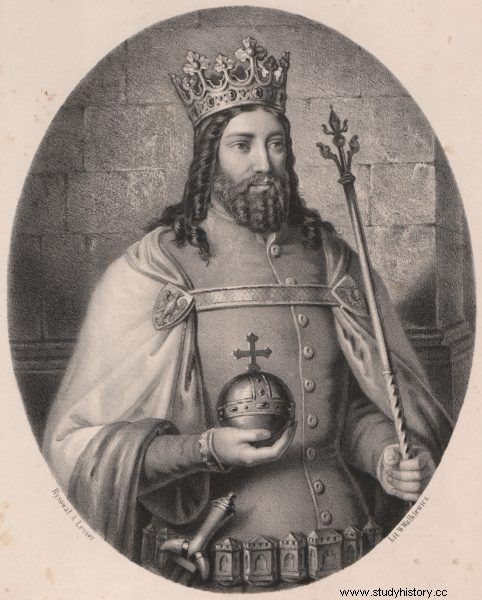In the light of the church law, marriages were unbreakable and for life. There were, however, many exceptions to this rule. What did you have to do to get a divorce in the Middle Ages?
The legal separation of husband and wife in the Middle Ages could only take place if the church authorities annulled their relationship - and thus found that it was never properly concluded. The list of circumstances allowing such a decision to be made was very limited, and it grew shorter as the centuries passed.
Among the Polish rulers, Kazimierz Wielki undertook strenuous efforts to annul his relationship - a king deprived of male descendants, whose second wife, Adelaide Heska, turned out to be sterile. What arguments could the ruler use, and what seemingly reasonable accusations were out of the question?
Betrayal, heresy, physical violence? It's not enough
In the times of Kazimierz, i.e. in the fourteenth century, it was no longer possible to request a divorce just because the partner was treason . One of the popes, Innocent IV, even considered it appropriate to point out that the basis for the breakup was not anal intercourse that a husband does with strange men. On the other hand, the decision of the same holy father to annul the relationship could have been requested by a woman whom her husband forced to practice such acts.

Wedding of Louis VIII and Eleonora Aquitaine in a 14th-century miniature
Lots of grave offenses like heresy or apostasy , was the basis only for the separation, but not for the complete separation of the spouses. Also my husband's brutality did not give the woman the right to break with him.
Good reason for divorce
The legal grounds for divorce were mainly forced to marry for example, by kidnapping the bride. Marriages with complete impotents were also irrelevant or finally - with the castrats, although on the details of the details the people of the Church differed in their opinions.
The influential English jurist William of Pagula insisted that men who were castrated after marriage must not be discriminated against, but Thomas Aquinas was of the opinion that permanent inability to mate was always an obstacle to divorce.
Much attention was paid to the origins of sexual impairment. Church authorities looked favorably upon, for example, men who had lost strength in a member as a result of (allegedly) witchcraft. They were even given three years to overcome their spells and regain form. In disputed cases, where a husband had disowned his condition, testimony from neighbors was obtained, sworn declarations were requested, and sometimes physical examinations were carried out.
Studies not quite clinical
In England of this period, church courts even employed women of good repute, whose role was to prove the impotence of the defendants. Their purpose was to excite the man. For this purpose, they were allowed to bare the breasts, kiss and caress the delinquent, as well as touch his genitals. If a man remained insensitive to all these practices, he was judged unfit to be a husband.

Casimir the Great as imagined by A. Lesser.
In the case of women, the research aimed primarily at determining whether the hymen had been ruptured - and thus whether the wife had allowed her husband to have sex. The jurors were of the opinion that female coldness was easier to overcome than impotence. William of Pagula even suggested surgical opening of access to the vagina or ... temporary substitution of a woman with a partner with organs that, due to its size, give a better chance of piercing the hymen.
Is sterility enough?
In the case of the relationship between Kazimierz and Adelaide, neither of these problems occurred. Kazimierz did not even try to pretend that he was suffering from a weakness in his penis. Anyway, if he was called as witnesses, dozens of his illegitimate partners could testify otherwise. It was also difficult to prove that the relationship was never consummated or that Adelaide suddenly lost her ability to have sexual intercourse.
When demanding a divorce, Kazimierz could only use one argument:the wife's proven sterility. However, it was already very shaky ground. In the fourteenth century, the inability of a woman to bear children was not yet considered a sufficient incentive for divorce, especially if it was not known before marriage and if the relationship was bodily accomplished.
For rulers and wealthy, popes made exceptions, but only when both sides agreed to split up or when it was in the curia's political interest. Kazimierz - unable to contain the anger of his sister seeking revenge for her son's death - could not count on Avignon's favor. Nor was he able to convince Adelaide to go to his hand, to renounce the crown, and to consent to the cancellation of the herd.
Selected bibliography:
The article was based on materials collected by the author during the work on the book "Ladies of the Polish Empire. The Women Who Built a Power " . Some of these items are shown below. Full bibliography in the book.
- Brundage J.A., Law, Sex, and Christian Society in Medieval Europe , The University of Chicago Press, Chicago-London 1990.
- Donahue C., Humanists and the Second Scholastic - European Marriage Law [in:] Law and Religion. The Legal Teachings of the Protestant and Catholic Reformations , eds. W. Decock, J.J. Ballor, M. Germann, L. Waelkens, Vandenhoeck &Ruprecht, Bristol 2014.
- Donahue C., Law, Marriage, and Society in the Later Middle Ages. Arguments about Marriage in Five Courts , Cambridge University Press, Cambridge 2008.
- Donahue C., The Legal Background [in:] Marriage in Europe 1400-1800 , ed. S.S. Menchi, University of Toronto Press, Toronto 2016.
- Krawiec A., Sexuality in Medieval Poland , Poznań Publishing House, Poznań 2000.
- Śliwiński J., The marriages of Casimir the Great. A study in the field of morality and ethics of the royal court in Poland in the 14th century , Pedagogical University in Olsztyn, Olsztyn 1987.
- Lind G., Common Law Marriage. A Legal Institution for Cohabitation , Oxford University Press, Oxford-New York 2008.
- Women and Gender in Medieval Europe. An Encyclopedia , Ed. M. Schaus, Routledge, New York-London 2006.
